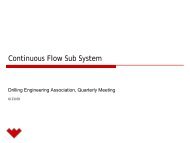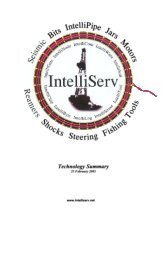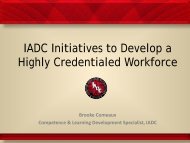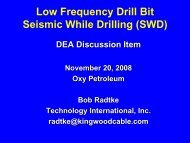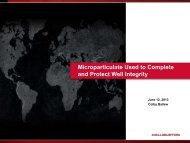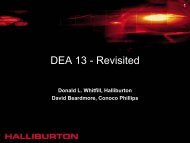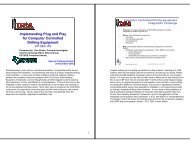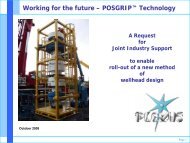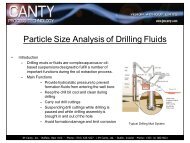Drill Pipe Fatigue Tracking System Validation - Drilling Engineering ...
Drill Pipe Fatigue Tracking System Validation - Drilling Engineering ...
Drill Pipe Fatigue Tracking System Validation - Drilling Engineering ...
You also want an ePaper? Increase the reach of your titles
YUMPU automatically turns print PDFs into web optimized ePapers that Google loves.
<strong>Drill</strong> <strong>Pipe</strong> <strong>Fatigue</strong> <strong>Tracking</strong> <strong>System</strong><strong>Validation</strong>DEA Presentation March 23, 2010Ken Newman, P.E. NOV CTESCerberus for <strong>Drill</strong>ing - Designed and built as a joint projectbetween CTES and Fearnley Procter Group© 2010 NOV CTES 1
What is CfD?• Fearnley Procter and NOV CTES decided todevelop drill string design software based onthe NS-14 design manual• CTES (with the help of Prof Steve Tipton, U ofTulsa) is the industry leader with the CerberusCT and slickline (SL) fatigue software• Once CfD T&D was developed, Tipton providedthe calculations necessary for DP fatigue© 2010 NOV CTES2
NS-14NS-14 was created as a drill string designmanual to provide engineers with a set ofsimple tables to use when designing drillstrings.Included in the manual are the calculationsupon which all the tables are based. Thesecalculations are all based on API RP7Gformulae or common Industry formulae inuse by operators at the time NS-14 wascompiled.© 2010 NOV CTES 3
Cerberus for <strong>Drill</strong>ing• <strong>Drill</strong> string design and limits (NS-14)• Dynamic Finite Element Torque and Drag• <strong>Drill</strong> pipe fatigue• Stall torque simulation• Slip stick simulation• Casing wear• Jarring analysis© 2010 NOV CTES
<strong>Drill</strong> String Design and Analysis• Input your well, drill string and fluid.• Analyse torque and drag.• Analyse drill string design.Stiffness ratioBending strength ratiosVon misses analysisBuckling calculations• Perform a detailed review of connectionstresses, including seal area stress to preventgalling in drill string components.• Take into account bending and pressures inyour string tension calculations.• Perform previously complicated and timeconsuming drill string design reviews inseconds.• Menu-based software hierarchy.• Graphical well data created automaticallyLayered software, frontlayer for quick data entry.Back layers for advancedusers.© 2010 NOV CTES 5
<strong>Drill</strong> String Design Utility• Analyse connection stresses usually ignored.• DP data sheets created automatically.• Tri axial drill string design every time.Individual graphs change depending on doglegseverity and differential pressure.CFD features - 'Quick look' design reviews in thedrill string editor.Combined loading of drill string components(graph to left)Combined Loading of Tool Joint and Tube, takinginto account dogleg severity and internal/externalpressures (graph above)This makes CFD a very convenient package to usefor quick look string design projects.© 2010 NOV CTES 6
<strong>Drill</strong> String EditorQuickly choose a string of DP via 3drop boxes –OREnter advanced drill string andconnection information to define yourown specialist drill string component.<strong>Drill</strong> String Editor was designed to easily accommodate simple or complex equipmentselection© 2010 NOV CTES 7
FEA T&D Model Calculates Force,Torque & Moment© 2010 NOV CTES 9
Unique: Stall TorQStall TorQ is a unique method for preventing drill string twist-offs when performing rotational drilling ormilling operations.© 2010 NOV CTES 10
Unique: Slip StickSlip Stick is a unique method for preventing drill string twist-offs when performing rotational drilling ormilling operations.© 2010 NOV CTES 11
© 2010 NOV CTESCasing Wear
© 2010 NOV CTESCasing Wear
Dynamic Jarring Simulationjarring.wmv© 2010 NOV CTES
<strong>Drill</strong> String <strong>Fatigue</strong>• Intended to answer the questions:– When should the drill string be inspected?– How should stands be moved to minimize fatigue?– How will one DS compare to another DS?• Benefits:– Maximize the life of a drill string– Reduce the number of inspections required– Reduce the number of drill string failures© 2010 NOV CTES
What is <strong>Drill</strong> String <strong>Fatigue</strong>?• True <strong>Fatigue</strong> – currently ignored by drilling industry– New DP has no fatigue damage– Rotating DP in a curved section causes fatigue damage– <strong>Fatigue</strong> damage accumulates until a crack if formed– This type of fatigue is analogous to CT and SL “fatigue”• Fracture Mechanics – called “fatigue” by drilling industry– Start with a small crack– Rotating DP in a curved section causes the crack to propagate– Calculate the crack propagation through the wall thickness© 2010 NOV CTES
Current <strong>Drill</strong> String <strong>Fatigue</strong><strong>Tracking</strong> Process• Assume a crack exists just slightly smallerthan the inspection equipment can find• Use fracture mechanics to calculate the crackpropagation• When crack reaches a certain depth, inspectthe DP again• If no cracks are found, reset the calculation toa small crack and restart process• Currently CfD uses this historical process© 2010 NOV CTES17
DP Sections for <strong>Fatigue</strong> <strong>Tracking</strong>in CfD• <strong>Drill</strong> <strong>Pipe</strong> (DP) fatigue is tracked for “sections”of DP• All the joints in a section are assumed to bethe same• A section can be used in multiple drill strings,allowing it to be run with various BHAs, etc.• Joints or stands within a section can bemoved and/or replaced© 2010 NOV CTES 18
<strong>Fatigue</strong> Section “Locked”© 2010 NOV CTES 19
Example L Shaped Well© 2010 NOV CTES 20
Input Parameters to Calculate<strong>Fatigue</strong>© 2010 NOV CTES 21
<strong>Fatigue</strong> Calculation Process• An initial crack depth (0.04” in this example) is assumed ineach joint• The FEA is run in regular increments (200 ft in this case)• The forces, torques and moments from the FEA are used tocalculate the crack growth for each revolution using fracturemechanics equations from Prof. Steve Tipton, University ofTulsa• The accumulated crack growth is stored for the section• Multiple wells, or portions of wells, can be calculated at onetime• Additional tripping, reaming, drilling operations can beadded to the fatigue database© 2010 NOV CTES 22
<strong>Fatigue</strong> Profile from <strong>Drill</strong>ingExample Well© 2010 NOV CTES 23
Re-drilling Last 3,000 ft of theSame Example© 2010 NOV CTES 24
Joint Editor Used to Move High <strong>Fatigue</strong>Stands to Top© 2010 NOV CTES 25
Database of <strong>Fatigue</strong> EventHistory - pulled in for next well© 2010 NOV CTES 26
Next Well – Same Example© 2010 NOV CTES 27
Next Well with no Joints Moved© 2010 NOV CTES 28
DEA Project - Objectives• Acquire data for actual drill strings– DS info, EDR data for each operation, history ofchanges to DS sections– Participants would identify DS for tracking andobtain required data• NOV CTES (with Tipton) will develop truefatigue calculation• Use data acquired to validate model• Full report to participants© 2010 NOV CTES29
DEA Project - Proposal• <strong>Validation</strong> process to be performed on 10 drillstrings over 18 months• Five participants sought who would pay $25Keach to participate and would agree toprovide the required data for 2 drill strings• Each participant will receive a copy of CfD forthe duration of the project© 2010 NOV CTES30
Questions?© 2010 NOV CTES 31


